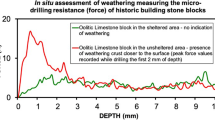Abstract
The late Ptolemaic temple of Athribis in Upper Egypt is built of regional limestone and preciously decorated with reliefs, inscriptions, plaster and polychromy. It is collapsed and only partly preserved and it disposes of some still buried rooms. The temple is situated in a desert climate and highly contaminated with soluble salts. Based on mappings of materials and preservation conditions, on investigations into the materials used and the damaging factors the development of a conservation conception for the limestone remains has been started. Conservation materials have been selected or are specially developed. A test area for some tasks has been prepared and controlled after 1 year of exposure. The paper shows the status quo of the work of the stone conservation group in an archaeological site in desert climate.













Similar content being viewed by others
References
All met sat: http://de.allmetsat.com/klima/aegypten. Cited 4 January 2008
Blanckenhorn M (1921) Ägypten. Handbuch der Regionalen Geologie VII/9
Bowitz J, Ehling A (2008) Non-destructive infrared analyses: a method for provenance analyses of sandstones. Environ Geol doi: 10.1007/s00254-008-1361-6
Bundesverband deutscher Gipsindustrie (2006) Gips-Datenbuch (Gypsum databook)
Charola AE, Pühringer J, Steiger M (2007) Gypsum: a review of its role in the deterioration of building materials. Environ Geol 52:330–352
Erfurt and Krompholz (1996) Anwendung von Dehnwellenmessungen für Baustoffuntersuchungen (Application of extensional wave measurements for testing construction materials). Beiträge zur Baustoffforschung - Wissenschaftliche Zeitschrift Heft 4/5: 95–101 http://www.geotron.de/DOWNLOAD/Anwendung%20Dehnwellenmessungen.pdf. Cited 4 January 2008
Fitzner B, Heinrichs K, Kownatzki R (1995) Weathering forms—classification and mapping. In: Snethlage R (ed) Denkmalpflege und Naturwissenschaft—Natursteinkonservierung 1 (Monument care and natural science—stone conservation 1), 41–88
Franke W (2007) Wüste (Desert) Freie Universität Berlin.http://www.geo.fu-berlin.de/geol/fachrichtungen/geochemhydromin/mineralogie/pdf/Hoererskripte-Wueste_07.pdf. Cited 10 April 2007
Grimm W-D (1999) Beobachtungen und Überlegungen zur Verformung von Marmorobjekten durch Gefügeauflockerung (Oberservations and reflections on the deformation of marble objects caused by structural breaking-up). ZDGG 150(2):195–235
Jürgens Chr (2007) Development of a conservation plan for weathered limestone in the Repit temple of Athribis, Egypt. Dissertation, Cologne University of Applied Sciences, Germany [in German]
Kebeasy RM (1990) Seismicity. In: Said R (ed) The geology of Egypt. Balkema, Rotterdam, pp 51–59
Klemm R, Klemm DD (1993) Steine und Steinbrüche im Alten Ägypten (Stones and quarries in old Egypt). Springer, Berlin
Leisen H, von Plehwe-Leisen E, Verbeek N (in press) Untersuchung der Bau- und Dekorationsmaterialien (Investigation into the construction and decoration materials). In: Leitz Chr, El-Masry Y, El-Sayed R (eds) Athribis I. Institut Français d’Archéologie Orientale (IFAO)
Petrie WMF (1908) Athribis. British School of Archaeology in Egypt and Egyptian Research Account. 14th year. London
Sampsel BM (2003) A Traveler’s guide to the geology of Egypt. The American University in Cairo Press, New York
Said R (1990) Cenozoic. In: Said R (ed) The geology of Egypt. Balkema, Rotterdam, pp 9–26
Siegesmund S, Weiss T, Vollbrecht A, Ullemeyer K (1999) Marble as a natural building stone. ZDGG 150/2:237–257
Snethlage R (2005) Leitfaden Steinkonservierung (Guideline for stone conservation), 2nd revised edn., IRB, Stuttgart
Szilagyi J (1995) Leitgesteine für die Denkmalpflege—Untersuchung petropysikalischer Eigenschaften (Key rocks for monument care—investigation into petrophysical properties) Research Report Technical University Dresden http://www.de/biw/geotechnik/geologie/forschung/download/forschung_leitgesteine.pdf. Cited 4 January 2008
Volland K (2008) Die Erde (The earth) Leipnitz Rechenzentrum, München. http://www.lrz-muenchen.de/~volland/vhb/einblicke/steine.pdf. Cited 10 April 2008
Wendler E, Snethlage R (1989) Der Wassereindringprüfer nach Karsten—Anwendung und Interpretation der Messwerte (The Karsten tube—application and interpretation of the results). Bautenschutz und Bausanierung 12:110–115
WTA Guideline 3-13-01/E (2005) Non-destructive desalination of natural stones and other porous building materials with poultices
Acknowledgments
The authors want to thank the German Research Foundation (DFG) for funding the project and the Thyssen-Foundation for supporting the first campaign of the conservation group. They want to express thanks to Prof. Dr. W.-G. Grimm for sharing his enthusiasm for stone and its conservation with them and to Prof. Dr. Siegfried Siegesmund for encouraging the publication of the paper.
Author information
Authors and Affiliations
Corresponding author
Rights and permissions
About this article
Cite this article
Leisen, H., von Plehwe-Leisen, E., Verbeek, C. et al. Aspects of conservation in the excavation site of the Athribis temple in Egypt. Environ Geol 56, 689–697 (2008). https://doi.org/10.1007/s00254-008-1473-z
Received:
Accepted:
Published:
Issue Date:
DOI: https://doi.org/10.1007/s00254-008-1473-z




